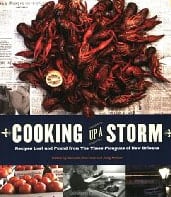Every weekend, I review a cookbook in an attempt to lend some guidance in a field that has become overrun. These days everyone is writing cookbooks and it is incredibly upsetting to buy a dud and have it sit on your shelf for years – staring at you, mocking your poor judgment.
It’s hard to imagine a city in America that is more food oriented than New Orleans. I mean, I’ve never even been there (blasphemy I know) and I still know that to be true. Sure. There is good food in New York, but the people in New Orleans live for food.
When Hurricane Katrina came through in 2005, besides destroying homes and lives, it destroyed recipes which almost destroyed a culture. “Cooking Up a Storm” edited by Marcelle Bienvenu and Judy Walker is the compiled efforts of local chefs and amateur cooks to restore the lost recipes.
Exchange Alley. On Oct. 27, 2005, The Times-Picayune of New Orleans started a column based on a reader’s request. The column would work as a recipe exchange where readers could write in asking for a lost recipe or just one of their favorites and then someone would answer with the recipe. This turned out to be a huge success and helped to restore the food culture of a city.
A letter from a resident to the paper:
“Thank you so much for this project! The one recipe I really need is the mirliton casserole. It tasted like my Grandma’s. I had tried to duplicate her recipe over the yearrs but never quite could. I made the recipe for Thanksgiving after it was in the paper and my mother wondered where I got the old family recipe!”
This book includes 225 recipes from those columns. As an outsider, it is a fantastic look into the New Orleans food world.
Behind the recipes. One of the really pleasant parts of this book is that a good number of the recipes include a small paragraph or two describing the history behind the dish. How it was created, who created it, and sometimes just how to pronounce it! As someone who really enjoys food, but knows very little about New Orleans, I found this to be extremely interesting.
One example that I really enjoyed involves the history behind the classic drink, the Sazerac. The name is based on an imported brand of Cognac, Sazerac-de-Forge et Fils. However, it no longer contains that ingredient. In 1949, the Roosevelt Hotel obtained rights to use the trademark, Sazerac, and opened a bar with the same name. The hotel was later renamed The Fairmont, and its doors were locked because of Katrina. The recipe in the book is a reprint of the Fairmont recipe.
A little something. When I read a cookbook, it usually becomes very apparent what kind of book it will be based on the appetizers presented. They set the mood for the book and give you a good idea for what’s to come from the recipes. The appetizers in this book are all over the place and I like that. There are very simple ones like basic cheese puffs and much more complex and specific recipes like Frank Brigston’s Marinated Crab Claws with Green Onion Sauce.
While reading, it really hit me that each of these recipes had been tested and tried many more times than most recipes in most books. They were also not picked by a single person, but by a city. That made me really excited to try some of them and read further.
Gumbo and Jambalaya. As stereotypical as it might be, when I think New Orleans, these are the things I think of. And guess what. This book doesn’t disappoint. There are 5 different, very different, gumbo recipes and a few jambalaya recipes. Everything from Chicken and Sausage Gumbo to Turkey Bone Gumbo and a great recipe simply called Jumbalaya, My Way.
Seafood! There is a lot of seafood in this book. In fact, if someone asked me if they should buy it, I would first ask if they liked Creole food, but second I would confirm that they like seafood. I would guess that roughly 1/3 of the recipes in the book have some kind of seafood in them. For me this is fantastic, because I love seafood. Especially when it is coated in hot sauce.
The Sweetness. I wouldn’t be doing this book justice if I didn’t mention the almost 100 pages of sweets that this book brings. I don’t really have a sweet tooth so I wasn’t as interested in these recipes, but the editors definitely provide all the classics. Everything from King Cake, to Bananas Foster and Carol Klein’s Turtle Cookies. I don’t know who Carol Klein is exactly, but her turtle cookies look pretty tasty.
I haven’t really heard much about this book which is why I’m glad I got a chance to review it. I haven’t seen it on any major bestseller lists and I’m pretty sure Oprah hasn’t given it her nod of approval. That said, I was really impressed by what was in its pages. It wasn’t filled with a lot of fluff or photos.
It is filled with fantastic, traditional recipes and the occasional story behind those recipes. That’s all your find here. But really, what else do you need?

